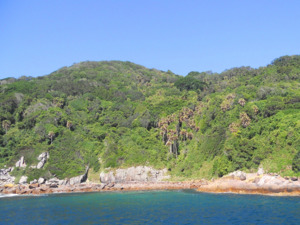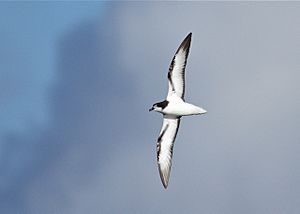Cabbage Tree Island facts for kids
Quick facts for kids John Gould Nature ReserveNew South Wales |
|
|---|---|
|
IUCN Category IV (Habitat/Species Management Area)
|
|
| Nearest town or city | Shoal Bay |
| Area | 30 ha (74 acres) |
| Managing authorities | NSW National Parks and Wildlife Service |
| See also | Protected areas of New South Wales |
Cabbage Tree Island, also known as the John Gould Nature Reserve, is a special protected nature reserve in New South Wales, Australia. It's an island that no one lives on. The island is about 1.4 km (0.87 mi) away from the coast of Port Stephens.
This island is 30 ha (74-acre) big. It got its name from the Cabbage-tree Palms that grow there. These palms are very important. They are a nesting spot for a special bird called the Gould's petrel. This island is the main breeding place for these rare birds. Because of this, it's known as an Important Bird Area.
Contents
About Cabbage Tree Island
Cabbage Tree Island is a small, rugged island. It is about 1 km (1 mi) long and 480 m (1,570 ft) wide. The island rises steeply to 123 m (404 ft) high.
Besides the Cabbage-tree palms, other trees grow here. These include deciduous and sandpaper figs. You can also find native plums and bird-lime trees.
Island History and Protection
In 1911, a baby penguin was found on Cabbage Tree Island. People tried to keep it as a pet in Maitland. Over time, people learned more about nature. They realized how important it was to protect places like this island.
Protecting the Island
Cabbage Tree Island is now a special nature reserve. It is protected by the New South Wales National Parks and Wildlife Act. This law helps keep the island's natural home safe. Only scientists and conservation workers are allowed to visit. This helps protect the island's plants and animals.
Helping Gould's Petrels
Gould's petrels build their nests in natural rock cracks. These cracks are found in two valleys on the island's western side. They also nest in hollow palm trunks and under fallen palm leaves. Sometimes, they use spaces in fig tree roots. These birds nest close together in groups.
Years ago, the number of petrels was going down. One big problem was rabbits. The rabbits ate most of the small plants on the island. This left the ground-nesting petrels exposed. Birds like pied currawongs and Australian ravens could easily find them.
The lack of plants also caused another problem. Sticky fruits from bird-lime trees would fall to the ground. The petrels would get stuck in them. By 1992, there were fewer than 250 pairs of petrels nesting. Not many young birds were surviving.
Since 1992, people have worked hard to help the petrels. They removed all the rabbits from the island by 1998. They also took away bird-lime trees from nesting areas. Currawongs and ravens were also managed.
In 1995, a few petrels were found on Boondelbah Island, nearby. So, young petrels from Cabbage Tree Island were moved there. This helped start a new group of birds. By 2004/05, the number of petrels on Cabbage Tree Island had grown a lot. There were about 2,500 birds, with 1,000 breeding pairs. Now, many more young petrels survive each year.
Images for kids





